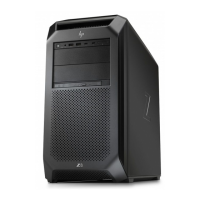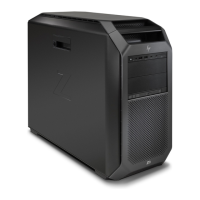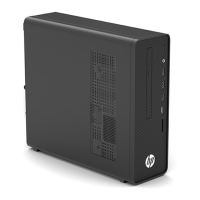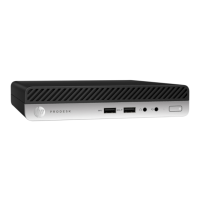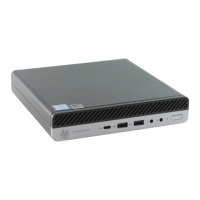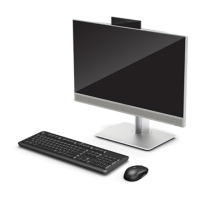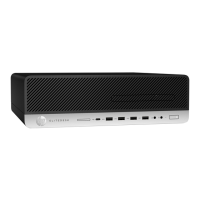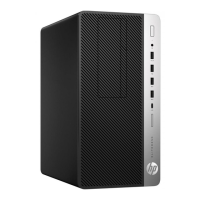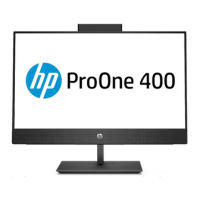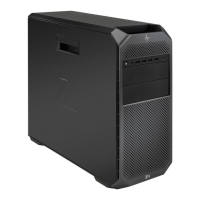
Do you have a question about the HP Z4 G4 and is the answer not in the manual?
| Tcase | 65 °C |
|---|---|
| Bus type | QPI |
| Stepping | U0 |
| Processor cache | 8.25 MB |
| Processor cores | 6 |
| Processor model | W-2133 |
| System bus rate | 0 GT/s |
| Processor socket | LGA 2066 (Socket R4) |
| Processor threads | 12 |
| Processor codename | Skylake |
| Processor frequency | 3.6 GHz |
| Processor lithography | 14 nm |
| Processor manufacturer | Intel |
| PCI Express slots version | 3.0 |
| Processor boost frequency | 3.9 GHz |
| Processor operating modes | 64-bit |
| ECC supported by processor | Yes |
| PCI Express configurations | 1x16, 1x4, 1x8 |
| Thermal Design Power (TDP) | 140 W |
| Number of processors installed | 1 |
| Maximum number of PCI Express lanes | 48 |
| Memory types supported by processor | DDR4-SDRAM |
| Memory clock speeds supported by processor | 1600, 1866, 2133, 2400, 2666 MHz |
| Memory bandwidth supported by processor (max) | 85.3 GB/s |
| Maximum internal memory supported by processor | 512 GB |
| Operating system installed | Windows 10 Pro for Workstations |
| Memory slots | 8x DIMM |
| Internal memory | 16 GB |
| Memory channels | Quad-channel |
| Memory clock speed | 2666 MHz |
| Maximum internal memory | 256 GB |
| Memory layout (slots x size) | 2 x 8 GB |
| HDD speed | 7200 RPM |
| RAID levels | 0, 1, 5, 10 |
| HDD capacity | 1000 GB |
| SSD capacity | The Solid State Drive's storage capacity in Gigabytes. |
| HDD interface | SATA |
| SSD interface | PCI Express |
| Storage media | HDD+SSD |
| Optical drive type | DVD-RW |
| Card reader integrated | No |
| Total storage capacity | 1256 GB |
| Discrete graphics card model | Not available |
| Power supply | 1000 W |
| USB 2.0 ports quantity | USB 2.0 ports have a data transmission speed of 480 Mbps, and are backwards compatible with USB 1.1 ports. You can connect all kinds of peripheral devices to them. |
| USB 3.2 Gen 1 (3.1 Gen 1) Type-A ports quantity | 10 |
| USB 3.2 Gen 1 (3.1 Gen 1) Type-C ports quantity | 0 |
| USB 3.2 Gen 2 (3.1 Gen 2) Type-C ports quantity | 2 |
| Sustainability certificates | ENERGY STAR |
| Chassis type | Tower |
| Product color | Black |
| Country of origin | China |
| Intel® vPro™ Platform Eligibility | - |
| Audio chip | Realtek HD ALC221 |
| Product type | Workstation |
| Motherboard chipset | Intel® C422 |
| Scalability | 1S |
| Processor code | SR3LL |
| Processor ARK ID | 125040 |
| Processor package size | 45 x 52.5 mm |
| Supported instruction sets | AVX, AVX 2.0, AVX-512, SSE4.2 |
| Intel Identity Protection Technology version | 1.00 |
| Depth | 445 mm |
|---|---|
| Width | 169 mm |
| Height | 386 mm |
| Weight | 10200 g |
Details the standard features that may vary depending on the specific computer model.
Identifies and describes the components located on the front panel of the computer.
Identifies and describes the components located on the rear panel of the computer.
Identifies and describes the components located on the left side of the computer.
Provides information on where to find the computer's serial and product ID numbers.
Lists and illustrates the main components of the computer for identification.
Explains the danger of static discharge and how it affects electronics.
Provides precautions for preventing ESD damage to components and equipment.
Lists precautions for grounding the work area to prevent static damage.
Provides guidelines to prevent overheating and prolong computer life.
Covers general cleaning safety, computer case, and keyboard cleaning procedures.
Outlines essential considerations for disassembly and assembly of the computer.
Provides instructions on handling and maintaining cables and connectors.
Details proper handling of hard drives as delicate, precision components.
Explains the function and safety precautions for the coin cell battery.
Outlines essential safety procedures before opening the computer.
Step-by-step guide for removing and installing the front bezel.
Detailed steps for removing and installing the computer's access panel.
Procedure for removing and installing the FIOUI module.
Instructions for removing and installing storage devices.
Steps for removing and installing the memory fan assembly.
Procedure for removing and installing the front fan/PCIe and card guide assembly.
Detailed steps to remove and install the rear fan.
Instructions for removing and installing the CPU cooler assembly.
Step-by-step guide for removing and installing the processor.
Procedure for removing and installing the system board.
Instructions for removing and installing the power supply unit.
Overview of functions and capabilities of the Computer Setup (F10) Utility.
Step-by-step guide on how to access and navigate the Computer Setup utility.
Details options within the Main section of Computer Setup, including system information.
Covers security settings like BIOS administrator password and TPM configuration.
Explains advanced setup options for display, boot, and system configurations.
Procedure to restore computer configuration settings from saved media.
Guidance on establishing a safe and comfortable work environment.
Steps to isolate problems before contacting technical support.
General suggestions for troubleshooting computer, monitor, or software issues.
Provides solutions for common general problems encountered with the computer.
Lists common causes and solutions for power supply issues.
Addresses common issues and solutions related to hard drive errors.
Troubleshooting steps for issues with media card readers and media cards.
Guides users through troubleshooting common display and monitor issues.
Provides solutions for common audio issues like sound cutting in/out.
Troubleshooting steps for unrecognized front panel devices like USB or audio.
Solutions for issues related to connecting to the internet and launching programs.
Addresses common software issues like application errors or driver problems.
Lists POST errors with numeric codes and provides recommended actions.
Explains how to interpret diagnostic codes from LEDs and beeps.
Instructions for changing or deleting setup and power-on passwords.
Steps to reset CMOS values to factory defaults and its implications.
Guide to using the Windows-based utility for hardware diagnostics.
Instructions for downloading the HP PC Hardware Diagnostics Windows tool.
Steps for installing the HP PC Hardware Diagnostics Windows utility.
Guide to using the UEFI utility for hardware diagnostics outside the OS.
Steps to start the HP PC Hardware Diagnostics UEFI diagnostic tool.
Instructions for downloading the UEFI diagnostic tool to a USB drive.
Guide to download the latest version of HP PC Hardware Diagnostics UEFI.
Customizing settings for remote HP PC Hardware Diagnostics UEFI.
Utilizing Windows tools for backing up personal information and creating restore points.
Steps to create HP Recovery media using HP Recovery Manager.
Detailed guide on using HP Recovery Manager to create recovery media.
Instructions for creating recovery media with the HP Cloud Recovery Download Tool.
Overview of options for restoring, resetting, and refreshing the computer.
How to restore the computer using HP Recovery Manager or partition.
Procedure to recover the computer using HP Recovery Manager.
Steps to perform system recovery using the HP Recovery partition.
How to recover the computer using HP Recovery media.
Procedure to modify the computer's boot order in BIOS.
Steps to remove the HP Recovery partition to free up hard drive space.
General information and warnings for replacing the computer battery.
Instructions for replacing Type 1 and Type 2 battery holders.
Steps to restore nonvolatile memory to factory settings and manage BIOS.
Details types of nonvolatile memory and their usage characteristics.
How to restore BIOS settings to factory defaults.
Explains the differences between UEFI BIOS and legacy BIOS.
How to reset BIOS security to factory defaults and erase data.
Procedure to reset custom secure boot keys.
Information on HP Sure Start technology for BIOS protection.
Details computer dimensions, operating environment, and shock ratings.
Technical specifications for the power supply units (Wattage, Voltage, Frequency).
Technical characteristics and SMART ATA drive features.
Information on supported RAM amounts for HP Linux workstations.
Details built-in audio hardware support and features in Linux.
Enabling and using Intel Hyper-Threading Technology in Linux.
Recommendations for NVIDIA drivers and configuration on Linux.
Information on AMD graphics hardware and driver support in Linux.
